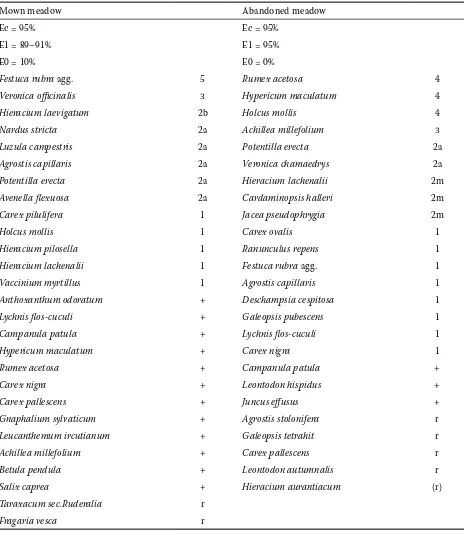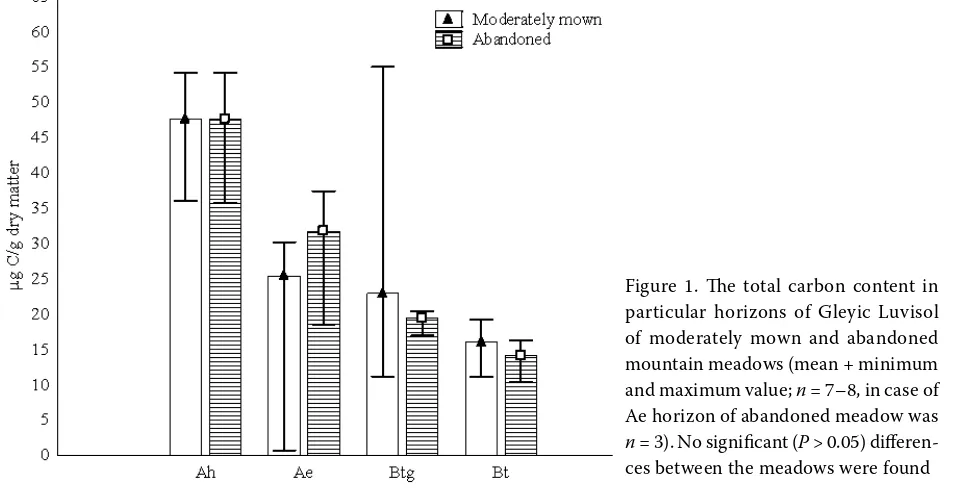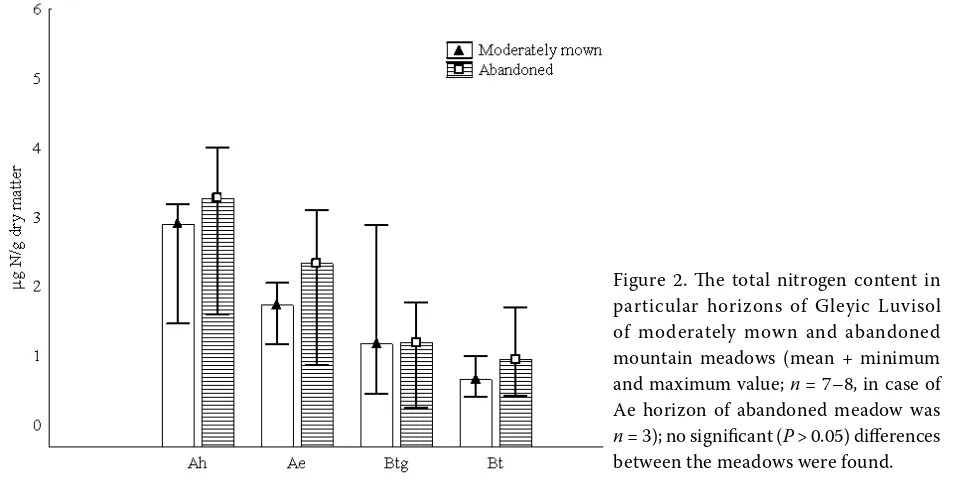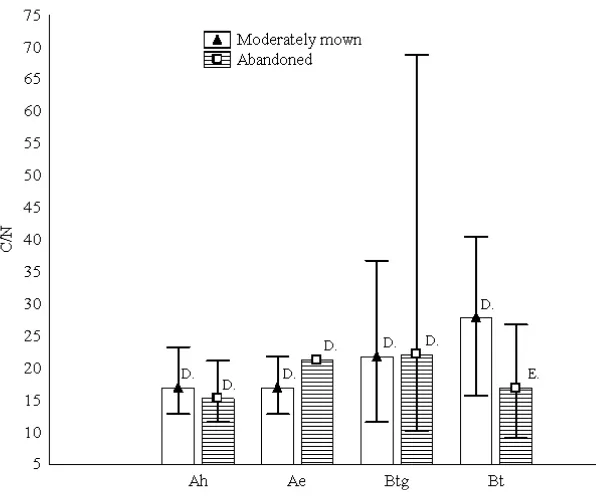A rapidly increasing part of formerly-managed meadows and pastures in the Alps has been aban-doned during the last decades, and is re-colonised by shrub and tree species. In the mountains of the Central Europe, large areas have been abandoned fairly recently after re-privatisation of land. These transformations actuate fundamental alterations of landscape pattern and ecosystem structure and func-tion, affecting the spatial structure of plant canopies,
species composition and physiology, nutrient avail-ability and in consequence the biosphere-atmosphere CO2 exchange, which in turn may feed back on the atmospheric CO2 concentrations (project Carbomont – Effects of land-use changes on sources, sinks and fluxes of carbon in European mountain areas – EVK2-CT2001-00125, EU, Framework 5).
The traditional management of meadows in mountain areas of the Czech Republic was mowing
Stand Heterogeneity of Total Carbon and Nitrogen,
and C/N Ratio in Soil of Mountain Meadows
Valerie VRanoVá
1, Pavel FoRmánek
1, klement Rejšek
1and Dalibor janouš
21
Department of Geology and Soil Science, mendel university of agriculture and
Forestry in Brno, Brno, Czech Republic;
2Institute of Systems Biology and ecology,
Laboratory of Plants ecological Physiology,
academy of Sciences the Czech Republic,
Brno, Czech Republic
Abstract:This study was aimed at monitoring the relative and absolute stand heterogeneity of total carbon, total nitrogen and C/N ratio in Ah-Ae-Btg-Bt horizons of Gleyic Luvisol on one mountain meadow divided into two study plots: one moderately (once a season) mown (plant community of the nardo-Callunetea class) and one abandoned for about 12 years (plant community of the molinio-arrhenatheretea class). The heterogeneities were evaluated more than 2 months after the mowing of the moderately mown meadow at the end of July 2005. Relative stand heterogeneity was expressed using coefficient of variation (CV), absolute stand heterogeneity using the differences between maximum and minimum value. When both meadows were taken into account, the relative stand heterogeneity of total carbon in individual horizons was < 65%, < 73% (total nitrogen), and < 93% (C/N). Lower relative and absolute stand heterogeneity of these parameters was mostly on the abandoned meadow. Relatively higher differences of stand heterogeneity between the meadows were evident in deeper parts of the soil (horizon Btg) and the lowest mainly in horizon Ah (or Bt). The accelerated accumulation of dead organic matter in the autumn caused the natural difference of these inputs not to be substantially eliminated by the presence or absence of mowing. Accelerated eluviation of organic compounds of higher nitrogen content significantly (P < 0.05) decreased the C/N ratio in the Bt horizon (n = 6–8) of the abandoned meadow.
Keywords: carbon; nitrogen; C/N ratio; mountain meadow
the abandonment of which started a secondary suc-cession with shrubs and trees re-colonizing these areas. This abandonment increased heterogeneity of plant coverage, and changes in root systems in size, depth and proportion of the living parts (Moravec et al. 1994; Fiala 1997). According to Holub and Tůma (2005), Formánek et al. (2007) and Vranová et al. (2008) variations in plant coverage of mountain meadows after the cessation of mowing were associated with deceleration of nutrient cycling, increased uptake of N, P and K, and with changes in C/N of below-ground and above-ground plant biomass or kinetic parameters of heterotrophic soil respiration.
Aim of this work is to verify the hypothesis about significant effects of human activity on concentrations and stand heterogeneity of total carbon (C) and total nitrogen (N) (and calculated C/N ratio) in particular horizons of Gleyic Luvisol. The human activity in this case was moderate mowing, specifically its abandonment. The sub-ject of this study was mountain meadows which were either continuously moderately mown or abandoned. We propose that the results obtained in this work can be used to test the effect of hu-man activity on processes in soil. Nevertheless, the authors acknowledge that the influence of climatic and soil conditions of flysch rocks of mountain vegetation zone of Central Europe should not be ignored.
MATeRiAl ANd MeTHodS
experimental plots
The experimental stand is located in the Moravi-an-Silesian Beskids Mountains in the northeast part of the Czech Republic (N 49°30’17”, E 18°32’28”), on a slope with an elevation of 825–860 m a.s.l. and southeast orientation. The local subcontinental climate in this region is characterised by mean annual air temperature of 4.9°C, mean relative air humidity of 80% and by mean annual precipitation of 1100 mm. The number of days with snow cover is 160 per year. The experimental meadow (1 ha) was originally mowed regularly, the hay removed and stored as feed for livestock. This traditional management ceased approximately 12 years ago on one half of the meadow (abandoned meadow). The remaining half has been continuously mod-erately mown (once a season). The modmod-erately mown meadow plant the community belongs to
the nardo-Callunetea class and the mowing treat-ment in season 2005 was applied there on 25 and 26 July. The abandoned meadow is characterised by a higher representation of forbs and commu-nity belongs to the molinio-arrhenatheretea class (Formánek et al. 2007). The plant cover proper-ties are listed in Table 1. Still, between-meadows differences in the total (above-ground and below-ground) biomass production were insignificant in 2004 (1889 ± 427 g/m2 versus 1758 ± 394 g/m2
abandoned and mown, respectively; mean ± SD; n = 5–6) (Holub & Tůma 2005). The abandoned meadow was characterised by higher litter ac-cumulation at the end of growing season, while the above-ground and below-ground biomass of moderately mown meadow had a higher C/N ratio. In 2003 and 2004 these values were 42.0 to 42.1 versus 22.7 to 29.5 (above-ground biomass of moderately mown versus abandoned meadows), and 37.6 to 42.5 versus from 27.3 to 28.9 (below-ground biomass of moderately mown versus abandoned meadows) (Holub & Tůma 2005).
Soil sampling
Soil type and sub-type on moderately mown and abandoned meadows is Gleyic Luvisol with follow-ing succession of horizons: O-Ah-Ae-Btg-Bt-Cg (ISSS-ISRIC-FAO2006). The depth was Cg > 78 cm on the moderately mown meadow and > 90 cm on the abandoned meadow. The soil texture classes of the horizons studied are described in Table 2. The surface humus form on both meadows was classified as leptomoder (Green et al. 1993). On each of the meadows four holes (15 × 15 × 70 cm) were dug by spade on every diagonal. From ho-rizons Ah-Ae-Btg-Bt we took soil samples and placed them into plastic bags. The Ae horizon was not developed in several cases of the abandoned meadow. After transportation to the laboratory, the samples were air-dried at room temperature and consequently sieved through 2 mm mesh size. Sieved samples were milled using Mixer Mill MM 200, Retsch, Germany. Soil sampling was performed in October 6–7, 2005.
Soil analysis
elemental nitrogen and carbon into carbon diox-ide. The gas mixture was then separated on a gas chromatographic column and measured using a thermoconductivity detector.
Statistical methods
[image:3.595.65.529.100.635.2]Statistical analysis of differences between soil of moderately mown and abandoned meadows was Table 1. Plant cover on the moderately mown and abandoned mountain meadows
Mown meadow Abandoned meadow
Ec = 95% Ec = 95%
E1 = 89–91% E1 = 95%
E0 = 10% E0 = 0%
Festuca rubra agg. 5 Rumex acetosa 4
Veronica officinalis 3 Hypericum maculatum 4
Hieracium laevigatum 2b Holcus mollis 4
nardus stricta 2a achillea millefolium 3
Luzula campestris 2a Potentilla erecta 2a
agrostis capillaris 2a Veronica chamaedrys 2a
Potentilla erecta 2a Hieracium lachenalii 2m
avenella flexuosa 2a Cardaminopsis halleri 2m
Carex pilulifera 1 jacea pseudophrygia 2m
Holcus mollis 1 Carex ovalis 1
Hieracium pilosella 1 Ranunculus repens 1
Hieracium lachenalii 1 Festuca rubra agg. 1
Vaccinium myrtillus 1 agrostis capillaris 1
anthoxanthum odoratum + Deschampsia cespitosa 1
Lychnis flos-cuculi + Galeopsis pubescens 1
Campanula patula + Lychnis flos-cuculi 1
Hypericum maculatum + Carex nigra 1
Rumex acetosa + Campanula patula +
Carex nigra + Leontodon hispidus +
Carex pallescens + juncus effusus +
Gnaphalium sylvaticum + agrostis stolonifera r
Leucanthemum ircutianum + Galeopsis tetrahit r
achillea millefolium + Carex pallescens r
Betula pendula + Leontodon autumnalis r
Salix caprea + Hieracium aurantiacum (r)
Taraxacum sec.Ruderalia r
Fragaria vesca r
Plant cover was estimated in 2003 (2 years before the performation of this experiment) on 25 m2 plots according to
performed by t-test for independent samples by groups. When preconditions for parametric testing were not fulfilled, nonparametric Mann-Whitney U test was used (Statistica 7.0). Coefficients of variation (CV) for particular soil properties and in particular horizons of each of the studied meadows were also calculated.
ReSulTS ANd diSCuSSioN
The results obtained in this study indicate that mean concentration of C (n = 3–8) was decreas-ing in succession of natural sequence of horizons Ah > Ae > Btg > Bt both on the moderately mown and abandoned meadows (Figure 1). Statistical
[image:4.595.63.533.114.285.2]analysis did not distinguish significantly (P > 0.05) different C in any of the particular horizons when the two meadows were compared. Higher relative stand heterogeneity of C expressed as coefficient of variation (CV) was found on the moderately mown meadow in all horizons (Table 3). The CV for C ranged from 16.01% to 64.16% (moderately mown) and from 6.58% to 33.70% (abandoned meadow). The absolute stand heterogeneity given by differences between the maximum and the minimum value ranged from 8.59 to 46.21 µg C/g of dry matter (DM) (moderately mown) and from 3.70 to 19.87 µg C/g of DM (abandoned meadow) (Table 4). Considerably higher stand heterogeneity for C was found on the moderately mown meadow Table 2. The content of clay, silt and sand in studied horizons of Gleyic Luvisol on moderately mown and abandoned meadows of Moravian-Silesian Beskids Mts with names of textural classes according to USDA-NRCS (1999)
Treatment Horizon Depth (cm) Clay Silt Sand Texture
(g/kg)
Moderately mown
Ah 8–21 186.0 260.0 554.0 sand loam
Ae 21–28 263.0 247.0 490.0 sand clay loam
Btg 28–42 313.0 248.0 439.0 clay loam
Bt 42–78 330.0 262.0 408.0 clay loam
Abandoned
Ah 8–16 199.3 271.3 529.3 sand loam
Ae 16–26 464.0 384.0 152.0 clay
Btg 26–38 476.0 412.0 112.0 silt clay
Bt 38–90 603.0 300.0 97.0 clay
[image:4.595.62.542.516.762.2]in horizon Btg when compared with the same ho-rizon of the abandoned meadow (Figure 1). The lowest differences between the two meadows were found in the Ah horizon (1.16%).
The mean N also decreased from Ah to Bt hori-zon (Figure 2). Mean concentrations of N in any of the particular horizons were not significantly (P > 0.05) increased on the abandoned meadow when the meadows were compared. The CV calcu-lated for N on both meadows ranged from 19.36% to 72.72%. The absolute stand heterogeneity ranged from 0.62 to 2.56 µg N/g of DM (Table 3 and 4). The highest differences in heterogeneity of N between the meadows were found in horizons Ae and Btg.
The mean C/N ratio (n = 6–8, in the case of the Ae horizon on the abandoned meadow n = 1) in particular, horizons ranged from 16.91 to 27.78 (mown meadow) and from 15.24 to 22.12 (aban-doned meadow) (Figure 3). Statistical analysis
indicated significantly (P < 0.05) lower C/N in Bt horizon of the abandoned meadow compared with the same horizon of the mown meadow. The relative and absolute stand heterogeneity of C/N in particular horizons of the mown meadow ranged from 19.42% to 39.15% and from 9.51% to 26.52%, respectively; on the abandoned meadow the het-erogeneities ranged from 20.62% to 92.48% and from 10.06 to 61.58 (Table 3 and 4).
Preliminary results show that stock of C or N in mineral soil of both meadows (horizons Ah-Ae-Btg-Bt; depth 8–78 cm and 8–90 cm, respectively) was similar (13.33 versus 13.36 g C per square centimetre).
Presented data illustrate the effect of human activ-ity on mountain meadows (Cannell&Thrornley 1998; Shukla et al. 2006). The twelve-year aban-donment of this activity on concentrations and spatial heterogeneity of C and N (plus calculated C/N ratio) is also presented. The abandonment of
[image:5.595.63.533.114.218.2]Figure 2. The total nitrogen content in particular horizons of Gleyic Luvisol of moderately mown and abandoned mountain meadows (mean + minimum and maximum value; n = 7–8, in case of Ae horizon of abandoned meadow was n = 3); no significant (P > 0.05) differences between the meadows were found. Table 3. Coefficients of variation in per cents calculated for C, Nand C/N in studied horizons of Gleyic Luvisol of moderately mown and abandoned meadows of Moravian-Silesian Beskids Mts
Horizon Soil properties
C mown/abandoned N mown/abandoned C/N mown/abandoned
Ah 16.01/14.85 20.45/27.70 21.17/20.62
Ae 43.16/33.70 19.36/53.44 19.42/not assessed
Btg 64.16/6.58 72.72/37.61 39.15/92.48
[image:5.595.61.539.519.759.2]the meadow did not result in significant changes (P-level 0.05) in concentrations of C or N in any of the horizons. This fact is accompanied by sig-nificant increase of soil organic matter quality (a decrease in C/N ratio) in deep horizon Bt, which was probably due to accelerated eluviation of or-ganic compounds of higher nitrogen content on the abandoned meadow. To evaluate the effect of abandonment on the studied soil parameters, only actual data (after 12 years) were available. We did not perform initial monitoring of soil properties before the abandonment.
The level of spatial heterogeneity of C (Throrn- ley & Cannell 2001; Blair et al. 2006) and N (Hutchings & Kristensen 1995; Cannell& Thrornley 2000), C/N respectively, in soil is given by natural behaviour of meadow ecosystems in conditions of no human intervention: human activity leads to an enhancement of natural dif-ferences in particular sampling points. This fact
[image:6.595.64.362.81.329.2]is illustrated by lower differences of carbon con-tents, i.e. lower CV, on the abandoned meadow. From the aspect of particular horizons, no explicit trends in stand heterogeneity were found on any of the meadows. If we compare the relative stand heterogeneity of the studied parameters in par-ticular horizons, the highest differences (> 35%) between the meadows were present in horizon Btg and the lowest mainly in horizon Ah (or Bt). A possible explanation of these findings showing relatively higher stand heterogeneity of C and N in the deeper Btg horizon (of the mown meadow) where human activity is of little effect, and on the other hand, homogenisation of differences between these parameters in the depths where human activ-ity (mowing) has very high impact (Ah horizon) is the time of sampling (identical on moderately mown as well as abandoned meadow). During autumn, accumulation of dead organic matter was accelerated. Therefore, natural differences Figure 3. The ratio C/N in particular horizons of Gleyic Luvisol of moderately mown and abandoned mountain meadows (mean + minimum and maximum value; n = 6–8, in case of Ae horizon of abandoned meadow was n = 1); the different letters mark significant (P < 0.05) differences between meadows
Table 4. Absolute stand heterogeneity of C, Nand C/N in particular horizons of Gleyic Luvisol of moderately mown and abandoned meadows of Moravian-Silesian Beskids Mts. given as a difference between maximum and minimum values
Horizon Soil properties
C (µg/g dry soil) mown/abandoned N (µg/g dry soil) mown/abandoned C/N mown/abandoned
Ah 19.14/19.37 1.82/2.53 11.04/10.06
Ae 31.07/19.87 0.93/2.36 9.51/not assessed
Btg 46.21/3.70 2.56/1.60 26.52/61.58
[image:6.595.64.534.655.755.2]of these inputs were not substantially eliminated by the presence or absence of human incidence (mowing). This could have affected results from horizon Ah but not from horizon Btg.
CoNCluSioNS
The relative stand heterogeneity of C, N and C/N in Ah-Ae-Btg-Bt horizons of moderately mown and abandoned mountain meadows on the same soil (Gleyic Luvisol) was < 65%, < 73% and < 93%, re-spectively. Twelve-year abandonment of the meadow decreased stand heterogeneity of these parameters. The effect of abandonment on this heterogeneity was very low in upper mineral horizon Ah (or deepest horizon Bt), and was the highest in horizon Btg. The low effect of abandonment on heterogeneity of the above mentioned properties in Ah horizon was probably due to time of sampling (autumn). The accelerated accumulation of dead organic matter in this period caused elimination of natural differences of these inputs on studied meadows. Accelerated eluviation of organic compounds of higher nitro-gen content due to abandonment of the meadow significantly (P < 0.05) decreased C/N ratio in the deepest Bt horizon.
References
Blair N., Faulkner R.D., Till A.R., Korschens M., Schulz E. (2006): Long-term management impacts on soil C, N and physical fertility: Part II: Bad Lauchstadt static and extreme FYM experiments. Soil & Tillage Research, 91: 39–47.
Cannell M.G.R., Thornley J. H.M. (1998): N-poor ecosystems may respond more to elevated (CO2) than N-rich ones in the long term. A model analysis of grassland. Global Change Biology, 4: 431–442. Cannell M.G.R., Thornley J.H.M. (2000): Nitrogen
states in plant ecosystems: a viewpoint. Annals of Botany, 86: 1161–1167.
Fiala K. (1997): Underground plant biomass of grassland communities in relation to mowing intensity. Acta Scientiarum Naturalium Academiae Scientiarum Bohe-micae, 31: 1–54.
Formánek P., Rejšek K., Vranova V., Marek M.V. (2007): Bio-available amino acids and mineral nitro-gen forms in soil of moderately mown and abandoned mountain meadows. Amino Acids, 33. (submitted) Green R.N., Rowbridge R.L., Klinka K. (1993): Towards
a taxonomic classification of humus forms. Supplement to Forest Science, 39, Monograph 29: 1–49.
Holub P., Tůma I. (2005): Biomass production and nutrient uptake of mountain meadows with different management. The Beskids Bulletin, 18: 69–72. Hutchings N.J., Kristensen I.S. (1995): Modelling
mineral nitrogen accumulation in grazed pasture: will more nitrogen leach from fertilized grass than unfertilized grass/clover? Grass Forage Science, 50: 300–313.
ISSS-ISRIC-FAO (2006): World Reference Base for Soil Resources. A framework for international Classification, Correlation and Communication. World Soil Resources Reports No. 103, Rome, FAO.
Moravec J., Blažková D., Husová M. et al. (1994): Fytocenologie. Academia, Praha.
Shukla M.K., Lal R., Ebinger M.(2006): Determing soil quality indicators by factor analysis. Soil & Tillage Research, 87: 194–204.
Thornley J.H.M., Cannell M.G.R.(2001): Soil carbon storage response to temperature: an hypothesis. Annals of Botany, 87: 591–598.
USDA-NRCS (1999): Soil Taxonomy. Agricultural Handbook, US Government Printing Office, Washington.
Vranová V., Formánek P., Rejšek K., Kisza L. (2008): Selected kinetic parameters of soil microbial respirati-on in the A horizrespirati-on of differently managed mountain forests and meadows of Moravian-Silesian Beskids Mts. Euroasian Soil Science, 41. (submitted)
Received for publication May 24, 2007 Accepted after corrections August 30, 2007
Corresponding author:
Ing. Valerie Vranová, Ph.D., Mendelova zemědělská a lesnická univerzita v Brně, ústav geologie a pedologie, Zemědělská 3, 613 00 Brno, Česká republika



